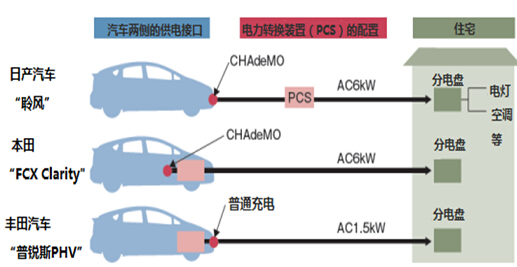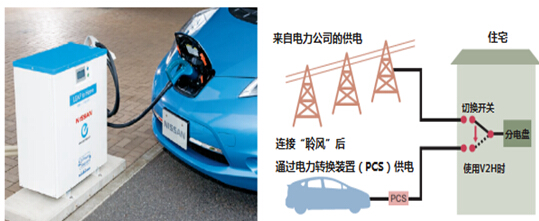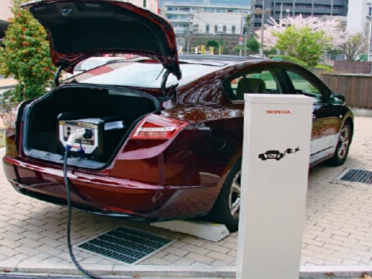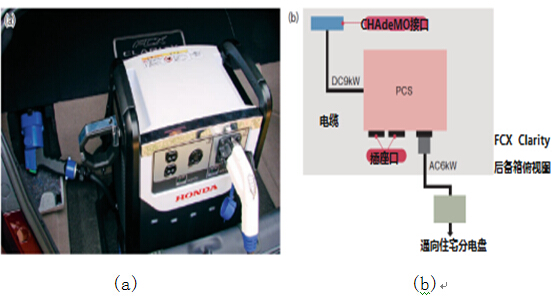Today, electric vehicles can not only provide transportation but also provide electricity to homes. The “V2H (Vehicle to home)†function with this feature has already begun its practical application in electric vehicles, and the functions of plug-in hybrid vehicles (PHVs) and fuel cell vehicles (FCVs) are also under development. This is unmatched by previous gasoline vehicles. The future energy conversion between cars and homes will most likely add new added value to the car.
At present, Japanese researchers have begun to explore the V2H system that is most suitable for popularizing electric vehicles to the public. His strength lies in being able to reduce the household's electricity bills through “the peak of electricity usage†and use it as an emergency power source during power outages.
Japan currently has a variety of residential power generation equipment such as solar power generation, home storage batteries, domestic fuel cells, and natural gas power generation. Since the Great East Japan Earthquake, Japan’s planned power outage policy has increased power cuts caused by natural disasters such as typhoons and storms. Nissan Motor Co. pointed out that “consumers’ actual demand for V2H is increasingâ€.
After automakers have added V2H functionality to electric vehicles, some manufacturers aim to simplify existing home power generation systems, and there are also vendors that combine with existing systems to make use more flexible and diverse. All manufacturers still hope to increase the added value of electric vehicles through the practical application of V2H, and to promote the further popularization of electric vehicles.

Figure 1 shows the basic structure of V2H. The home is powered by converting direct current into alternating current using a power conversion device (PCS). Different car manufacturers' PCS configurations and car output power modes are different.
Nissan to save cost

Fig. 2 V2H system of Nissan car
The world's first V2H system produced by Japan - the "EV power station" (manufactured by Nichicon) has sold about 2,000 units so far. This set of devices can convert 6kW of electricity from the EV “LEAF†lithium battery on board for home use.
Figure 2 shows the Nissan V2H system. The power conversion unit (PCS) manufactured by Nichicon is used as the “EV power station.†This device can output direct current from the fast charging interface of the Nissan car battery and convert it into alternating current in the PCS to output power for the home.
Of the 40,000 concerts sold in Japan, 5% of customers chose to purchase this system. The main selling point of promotion is to promote the system to reduce electricity bills by using peak power.
This system currently counts subsidies of 340,000 yen. After charging the battery with relatively inexpensive late-night power, it provides a portion of the electricity for the family during the day. Allegedly using this method, the initial cost can be recovered in about 7 years. In addition, the car itself almost eliminates the need to reconfigure the interface. Compared with the Toyota and Honda systems, the Nissan system places more emphasis on practicality.
In order to make the V2H system more practical, Nissan has effectively used existing systems to control production costs. Using the existing fast charging interface "CHAdeMO", power can be quickly output from the wind, saving more cost and labor compared to modifying the new interface. In addition, the EV power station is equipped with a toggle switch on the distribution board, and the user can be used to select to switch between using the power of the car or the power company; and when using the wind, the distribution board can physically separate the automobile from the power grid. , This eliminates the need for a separate license for system connections.
Although the sales volume of EV power stations is only 2,000 units, Nissan still plans to conduct a new development program to further study the manufacturing and sales of V2H systems in European and American countries. Nissan intends to sell more than 100,000 wind vehicles in the world. In particular, the night power in the United States is cheaper than Japan. If you use a car to store late-night power for daytime power generation, users can recover the cost in 2 to 3 years. This is shorter than in Japan.
Honda Motors provide more power

Figure 4 V2H system being tested in Honda. A portable power conversion device is installed in the trunk of a hydrogen fuel cell vehicle. When not using the V2H system, you can remove the PCS and make full use of the interior space.
Honda has already started trials of power supply applications using FCX Clarity for hydrogen fuel cell vehicles (FCV) (Figure 4). The FCV is characterized by a stronger power supply capability and can be used more effectively as an emergency power source in times of power outages.
Compared to a lithium battery with a capacity of 24 kWh in the Nissan LEAF, FCX Clarity has a 60 kWh power supply capacity, which is about 2.5 times that of the Nissan LEAF, which is equivalent to 6 days of power required by the average family. Having such a powerful power supply capacity is because the FCX Clarity vehicle is equipped with a large-capacity hydrogen tank to achieve a distance equivalent to that of a gasoline-powered vehicle.
In order to enable the car to save more energy, the power conversion device is designed to be mobile. In an unusual period, the equipment can be installed in the trunk of a car, and power can be supplied back and forth between several houses or public facilities. This system can be used more efficiently than electricity supply for only one house.
Another feature of FCV is that hydrogen can be replenished in a short time. As long as there is a hydrogen supplement station nearby, the on-board hydrogen tank can be filled within 3 minutes. However, even if EVs use a fast charging system, it takes about 30 minutes to fully charge them. When an emergency needs frequent power supply, it will inevitably be limited.
FCX Clarity not only has a powerful power supply capability, but in fact its output power is also quite high. The maximum output power of a hydrogen fuel cell generated by a chemical reaction between hydrogen and oxygen in the air can be as high as 100 kW, equivalent to the power consumption of 30 households. Honda’s Okabe said that “FCX Clarity eventually has potential as a mobile power stationâ€.
However, according to Japan's current electricity business law, power generation equipment with output power exceeding 10 kW will be certified as a power station and must be approved by the Ministry of Economy, Trade and Industry. Therefore, the product developed this time will control the output power below 10kW.
Specifically, the output power of each vehicle is 9 kW, of which 6 kW will be provided to the house through a power conversion device “removable substationâ€, and the remaining 3 kW will supply power to a 100-V outlet.

Figure 5 Power conversion device
(a) The maximum output power is 9 kW. 3kW of household appliances with direct interface, 6kW of power supply to residential buildings. The output current is connected to the car through the newly added CHAdeMO interface for the V2H system. (b) System composition. When using the V2H system, insert the plug of the residential-installed junction box into the PCS.
The main modification of the car itself is the need to increase the CHAdeMO interface. Unlike EV and PHV, FCV uses hydrogen as fuel, so there is no interface for normal charging and fast charging. Can not use the existing charging interface, FCX Clarity installed CHAdeMO interface in the trunk.
After inserting the plug of the junction box into the CHAdeMO connector of the car, DC power can be obtained from the car. However, the output current will not be output until the vehicle and the junction box have been safely checked by the Controller Area Network (CAN).
Honda plans to mass-produce FCVs in 2015 and will also plan to install ports corresponding to V2H. As FCV also needs to provide hydrogen-related infrastructure, the issue of the time-to-market for V2H mass-produced products for personal use is said to be "10 to 15 years later, that is, 2015 to 2030."
Toyota Motors use residential batteries
Toyota's experimental vehicle is an improved version of the power supply function added to the Prius PHV. However, the battery capacity of this model is only 4.4 kWh, and the output power is 1.5 kW, which is lower than the battery car and FCX. Therefore, in order to make up for smaller output power, the car's power will be sent to the home storage system for storage. When needed, the power distribution system uses the distribution board to output power to the home (see Figure 6).

Figure 6 V2H system being tested by Toyota Motor
(a) The battery is stored in the room from the general charging interface of the Prius PHV. (b) Store the power output from the car in the battery for daily use.
This use has two advantages. First, due to the use of a domestic power storage system, the power conversion device installed in the vehicle can be made low-cost and miniaturized. Second, even if the current output from the vehicle is not stable enough, the power conversion device inside the home battery can also be used. Get stable current.
Generally, the price of a household battery of about 1kW is usually more than 200,000 yen. If the automobile contains a battery, the cost will increase accordingly. The Prius PHV power conversion device using a home battery has thus successfully reduced costs.
In Toyota's application test, the Prius PHV can also perform system connections that Nissan and Honda systems cannot perform. The power storage system of the house itself has been approved by the individual system to obtain the system link. Therefore, the power company and the car can be used to supply electricity in the house, and Toyota's system has a relatively high utilization rate.
The car is equipped with two kinds of power lines for home use and emergency use. When the peak load is used for electricity, the daily power line is used to transport the car power into the storage battery. When needed, the electricity in the storage battery is transferred into the home through the distribution board.
On the other hand, under special circumstances such as power outages, tenants can manually switch the power cord and use the emergency power cord to directly supply power to a dedicated outlet (100V AC) in the house. In this special case, it is possible to supply power to the house without using a distribution board. In the emergency use, the Prius PHV can use gasoline to maintain the operation of the car's generator, plus the on-board battery (4.4kWh) can ensure the power supply capacity of 40kWh (available for general households for 4 days).
In the future, as an in-house power generation device connected to a home distribution board (an in-house power generation device that can be connected to a system), if an electric vehicle (EV, PHV, FCV, etc.) can be used in the same way as a residential solar power generation system, a battery, or a fuel cell, With the permission of the car power conversion device, the use of the V2H function will be easier.
In Toyota's application tests, in addition to Toyota's overall operation and the provision of automotive experiments, Denso was responsible for participating in the HEMS (Home Energy Management System) and charging and discharging stations, and Toyota Real Estate provided homes for them.
Japanese charger manufacturers develop guidelines
While car manufacturers continue to strengthen the V2H system structure, charger manufacturers are also committed to standardizing production. Although current chargers are only sold to Japanese automakers, charger manufacturers expect that foreign automakers will also introduce EVs and PHVs in Japan in the future. As a result, foreign charger manufacturers have gradually entered the market, which may lead to the diversification of V2H methods.
The EVPOSSA (Power Supply System Symposium for Electric Vehicles), which was formed by various charger manufacturers, announced the V2H guidelines at the end of April 2014. The guideline has established relevant regulations for V2H systems that use common charging and fast charging interfaces. Its release will also facilitate foreign manufacturers' adoption of the V2H system developed by Japan.
Aluminum Die Casting Lawn Mower Parts
Aluminum Die Casting Lawn Mower Parts are a metal forming process in which molten aluminum metal is put under pressure and injected into a die.
Aluminum weighs 1/3 of a comparable steel part. The aluminum parts would cost less to ship due to the weight and spend less expense than other manufacturing processes.
Aluminum Die Casting Lawn Mower Parts are lightweight alloys that have good corrosion resistance, mechanical properties, high thermal and electrical conductivity and strength at high temperatures. Aluminum alloys possess high dimensional stability for complex shapes and thin walls.



Aluminum Die Casting of Lawn Mower Parts and Accessories, Aluminum Die Casting Parts, Casting of Lawn Mower Parts, Aluminum Casting of Lawn Mower Parts
NINGBO ZHENHAI BOLANG METAL PRODUCT FACTORY , https://www.bldiecasting.com